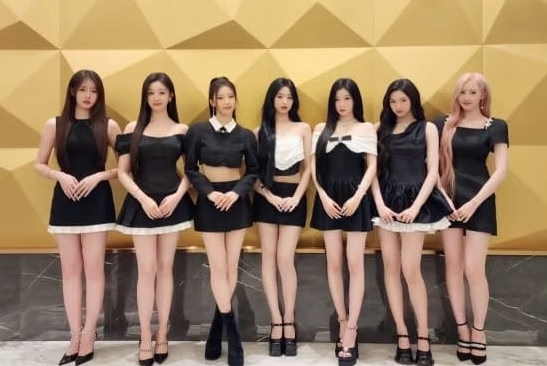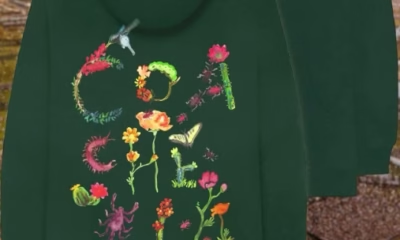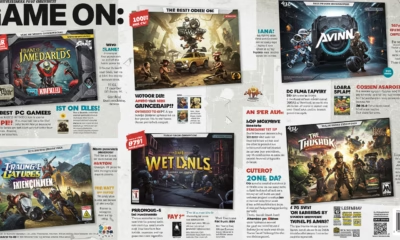ENTERTAINMENT
Court Prevents K-pop Group NewJeans from Independence

In a landmark ruling that has sent shockwaves through the K-pop industry, a South Korean court has blocked the popular girl group NewJeans from pursuing independence from their management company, HYBE. The decision, which comes amid a heated legal battle between the group and their label, has sparked widespread debate about the rights of artists, the power of entertainment agencies, and the future of K-pop. This ruling not only impacts NewJeans but also sets a precedent for other K-pop groups and artists seeking greater creative and financial autonomy.
Background of the Dispute
NewJeans, a rising star in the K-pop scene, debuted in 2022 under HYBE, one of South Korea’s largest entertainment companies. Known for their fresh sound, unique style, and relatable lyrics, the group quickly gained a massive following both domestically and internationally. However, behind the scenes, tensions were brewing between the members of NewJeans and their management.
The group’s members reportedly sought greater control over their music, image, and career trajectory, citing creative differences and dissatisfaction with HYBE’s handling of their brand. In early 2023, NewJeans filed a lawsuit against HYBE, seeking to terminate their contract and operate as an independent entity. The group argued that their contract was overly restrictive and did not allow them to fully express their artistic vision.
HYBE, on the other hand, countered that the contract was fair and legally binding. The company emphasised the significant investment it had made in NewJeans’ training, production, and promotion, arguing that the group’s success was a direct result of HYBE’s resources and expertise. HYBE also warned that allowing NewJeans to go independent could set a dangerous precedent, potentially destabilising the K-pop industry.
The Court’s Ruling
After months of legal proceedings, the South Korean court ruled in favour of HYBE, effectively preventing NewJeans from terminating their contract and operating independently. The court cited the terms of the contract, which it deemed legally valid, and emphasised the importance of upholding contractual agreements in the entertainment industry.
In its ruling, the court acknowledged the group’s desire for creative freedom but stated that such aspirations must be balanced against the legal and financial obligations outlined in their contract. The court also noted that HYBE had fulfilled its responsibilities as a management company, providing NewJeans with the resources and support needed to achieve their success.
The decision has been met with mixed reactions. While HYBE and its supporters have hailed the ruling as a victory for the stability of the K-pop industry, critics argue that it undermines the rights of artists and perpetuates a system that prioritises corporate interests over individual creativity.
Implications for NewJeans
For NewJeans, the court’s ruling is a significant setback. The group’s members had hoped to gain greater control over their music and careers, but they will now remain under HYBE’s management for the duration of their contract. This could lead to ongoing tensions between the group and their label, potentially affecting their creative output and public image.
The ruling also raises questions about the group’s future. Will NewJeans be able to reconcile their differences with HYBE and continue to thrive under the company’s management? Or will the legal battle and its aftermath hinder their growth and success? These are critical questions that only time will answer.
Broader Impact on the K-pop Industry
The court’s decision has far-reaching implications for the K-pop industry as a whole. For decades, K-pop has been dominated by a handful of major entertainment companies, often referred to as the “Big 4”: HYBE, SM Entertainment, YG Entertainment, and JYP Entertainment. These companies wield immense power, controlling every aspect of an artist’s career, from training and production to marketing and distribution.
While this system has produced some of the biggest names in global music, it has also been criticised for its rigid structure and lack of transparency. Many artists, particularly those who have achieved significant success, have expressed a desire for greater autonomy and a larger share of the profits generated by their work.
The NewJeans case highlights the challenges faced by artists seeking independence in an industry dominated by powerful corporations. It also underscores the need for greater legal protections for artists, particularly when it comes to contract negotiations and disputes.
The Debate Over Artist Rights
The court’s ruling has reignited the debate over artist rights in the K-pop industry. Supporters of NewJeans argue that artists should have the freedom to pursue their creative vision and control their careers. They point to the success of independent artists in other parts of the world as evidence that the traditional K-pop model is not the only path to success.
On the other hand, proponents of the current system argue that entertainment companies play a crucial role in the success of K-pop groups. They contend that the rigorous training, high-quality production, and extensive marketing provided by these companies are essential for achieving global success. Without the support of a major label, they argue, even the most talented artists may struggle to reach their full potential.
The Role of Contracts in the Entertainment Industry
The NewJeans case also highlights the importance of contracts in the entertainment industry. Contracts serve as the foundation of the relationship between artists and their management companies, outlining the rights and responsibilities of both parties. However, these contracts are often complex and heavily weighted in favour of the companies, leaving artists with limited bargaining power.
In recent years, there have been calls for greater transparency and fairness in contract negotiations. Some advocates have suggested the introduction of standardised contracts or the establishment of an independent body to oversee disputes between artists and management companies. These measures could help level the playing field and ensure that artists are treated fairly.
The Future of K-pop
The NewJeans case highlights the challenges and opportunities in K-pop’s evolving landscape. Although the court’s ruling hindered the group’s independence, it ignited a crucial conversation about the industry’s future. One potential shift is toward an artist-centric model, granting greater control and profit shares to artists. This could lead to the rise of independent labels, flexible contracts, or platforms connecting artists directly with fans. Conversely, major entertainment companies may continue to dominate, providing resources for polished, commercial success but limiting individual creativity. Transitioning to a balanced system requires addressing artist rights, fostering innovation, and ensuring fair practices. Ultimately, the industry must adapt to meet both artistic aspirations and commercial demands, shaping a sustainable future for K-pop.
Conclusion
The court’s decision to prevent NewJeans from going independent marks a pivotal moment in the K-pop industry. While it reinforces the power of major entertainment companies, it also highlights the growing demand for greater artist rights and creative freedom. As the industry continues to grapple with these issues, the NewJeans case serves as a reminder of the need for balance between corporate interests and individual aspirations. Whether this ruling will lead to meaningful change or further entrench the status quo remains to be seen. What is clear, however, is that the conversation about the future of K-pop is far from over.
ENTERTAINMENT
The Rise of 5th-Gen K-Pop: A New Era of Global Domination

The K-pop industry is constantly evolving, and with the rise of 5th-generation (5th-gen) groups, the global music scene is witnessing a fresh wave of talent, innovation, and record-breaking success. As 4th-gen groups like ENHYPEN, ITZY, Stray Kids, and IVE continue to dominate, a new batch of artists—BabyMonster, KISS OF LIFE, ZEROBASEONE, ILLIT, BOYNEXTDOOR, TWS, UNIS, and HEARTS2HEARTS—are carving their own paths with unique concepts, powerful performances, and next-level fan engagement.
In this article, we explore the defining traits of 5th-gen K-pop, the standout groups leading the charge, and what sets them apart in an increasingly competitive industry.
What Defines 5th-Gen K-Pop?
While there’s no official start date for the 5th generation, many fans and industry experts consider 2023–2024 as the beginning, marked by:
- Hyper-Globalization: Groups are debuting with multilingual members and targeting global markets from day one.
- AI & Tech Integration: AI-generated content, virtual avatars , and metaverse concerts are becoming standard.
- Short-Form Content Domination: TikTok and YouTube Shorts play a crucial role in viral success.
- Stronger Self-Production: More idols are involved in songwriting, producing, and creative direction.
- Hybrid Concepts: Blending multiple genres (K-pop, hip-hop, EDM, rock) and storytelling through music.
Now, let’s dive into the hottest 5th-gen groups making waves.
1. BABYMONSTER (YG Entertainment) – The Reborn Monster Rookies
Debut: 2024 (First Mini Album BABYMONS7ER) | Members: 7 (Ahyeon, Haram, Rora, Chiquita, Pharita, Ruka, Asa)
After generating massive hype with their pre-release single “BATTER UP” in 2023, BABYMONSTER officially debuted in 2024 with their first mini album BABYMONS7ER solidifying their place as YG Entertainment’s next powerhouse girl group. Originally introduced as a six-member act, the group’s final lineup expanded to seven with the return of Ahyeon, completing their full roster.
Why They Stand Out:
- Global lineup (Thailand, Japan, South Korea)
- Vocal powerhouses (Haram, Ahyeon, Rora, Pharita and Chiquita) and rap prodigies (Ruka, Asa)
- YG’s signature badass concept with a modern twist
2. KISS OF LIFE (S2 Entertainment) – The Self-Producing Queens
Debut: 2023 | Members: 4 (Julie, Natty, Belle, Haneul)
KISS OF LIFE is redefining independence in K-pop, with members heavily involved in writing and producing their music. Former Sixteen (JYP trainee) contestant Natty leads the group, bringing years of experience.
Why They Stand Out:
- Strong R&B and hip-hop influences (Tracks like “Shhh” and “Bad News”)
- Live vocals and raw performances—no lip-syncing!
- Mature, confident concept compared to many rookie groups
3. ZEROBASEONE (WakeOne Entertainment) – The Record-Breaking Kings
Debut: 2023 | Members: 9 (Zhang Hao, Sung Hanbin, Kim Jiwoong, Seok Matthew, Kim Taerae, Ricky, Kim Gyuvin, Park Gunwook, Han Yujin)
Formed from Mnet’s survival show Boys Planet, ZEROBASEONE (ZB1) shattered records with their debut album “YOUTH IN THE SHADE”, selling over 2 million copies—the highest for any K-pop debut.
Why They Stand Out:
- Elegant, fantasy-like concept (Tracks like “In Bloom”)
- Global fandom (Kep1er’s successor)
- Strong synchronization and vocal harmony
4. ILLIT (BELIFT LAB) – HYBE’s Next Big Thing
Debut: 2024 | Members: 5 (Yunah, Minju, Moka, Wonhee, Iroha)
Produced by HYBE (BTS’s label) and CJ ENM, ILLIT is following in the footsteps of NewJeans with a youthful, dreamy aesthetic. Their debut “Magnetic” went viral on TikTok, proving HYBE’s mastery of trendy, earworm music.
Why They Stand Out:
- Minimalist, Y2K-inspired fashion
- Addictive, easy-listening pop sound
- Strong social media presence
5. BOYNEXTDOOR (KOZ Entertainment) – Zico’s Hip-Hop Prodigies
Debut: 2023 | Members: 6 (Jaehyun, Sungho, Riwoo, Taesan, Leehan, Woonhak)
Under Zico’s label (KOZ Entertainment, a HYBE subsidiary), BOYNEXTDOOR brings a fresh, playful hip-hop vibe reminiscent of early BTS and Block B. Their tracks “One and Only” and “But Sometimes” showcase their laid-back yet charismatic energy.
Why They Stand Out:
- Self-written raps and lyrics
- Retro, street-style visuals
- Zico’s direct influence in production
6. TWS (PLEDIS Entertainment) – The New Emotional Pop Icons
Debut: 2024 | Members: 6
As SEVENTEEN’s younger brother group, TWS (pronounced “Twice”) focuses on emotional, relatable pop music. Their debut “plot twist” blends soft melodies with heartfelt lyrics, appealing to fans of TXT and ENHYPEN.
Why They Stand Out:
- Bright, sentimental concept
- Strong vocal and dance balance
- PLEDIS’s signature performance style
7. UNIS – The Survival Show Superstars
Debut: 2024 | Members: 8 (From Universe Ticket)
Formed through SBS’s survival show Universe Ticket, UNIS is a multinational girl group with a fresh, energetic concept. Their debut “SUPERWOMAN” highlights their powerful vocals and dynamic choreography.
Why They Stand Out:
- Diverse international lineup
- High-energy performances
- Fan-driven formation (like IZ*ONE)
8. HEARTS2HEARTS – The Underrated Vocal Powerhouses
Debut: 2025 | Members: 8
A new girl group gaining attention for their stunning vocal abilities, HEARTS2HEARTS is being compared to early MAMAMOO for their live-singing prowess.
Why They Stand Out:
- Focus on live vocals over heavy production
- Soulful, jazz-influenced sound
Conclusion: The Future of K-Pop is Here
The 5th generation of K-pop is breaking boundaries with global appeal, self-production, AI integration, and genre-blending sounds. From BABYMONSTER’s YG swag to HEARTS2HEARTS , these groups are redefining what it means to be a K-pop idol.
Which 5th-gen group is your favourite? With such fierce competition, one thing is clear—K-pop’s global dominance is only getting stronger.
ENTERTAINMENT
The Ultimate Guide to New Entertainment Trends in 2025

As we enter 2025, the entertainment industry is undergoing radical transformation, primarily due to rapid tech advancements. Not only are AI-generated films emerging, but VR experiences also offer unprecedented immersion. Meanwhile, interactive storytelling now allows viewers to shape narratives, thereby revolutionizing engagement. While these innovations excite audiences, they simultaneously challenge traditional media models. For instance, streaming platforms must now adapt or risk obsolescence. Consequently, content creators who embrace these trends will likely thrive, whereas those resisting change may fall behind. Ultimately, this evolution promises more personalized, dynamic entertainment for global audiences.
Whether you create, market, or simply love entertainment, understanding 2025’s trends isn’t just helpful—it’s essential. That’s why, in this guide, we’ll first explore AI’s role, then examine VR’s rise, and later analyze interactive content. Additionally, we’ll cover NFTs, while revealing sustainability shifts, before finally predicting what’s next. So, if you’re ready to future-proof your strategy, let’s dive right in.
- The Rise of AI in Entertainment
- Virtual Reality (VR) & Augmented Reality (AR) Domination
- Interactive & Choose-Your-Own-Adventure Content
- The Boom of Short-Form & Micro-Content
- Blockchain & NFTs in Media Monetization
- Hyper-Personalized Streaming Experiences
- Live, Social, and Community-Driven Entertainment
- Sustainability in Entertainment Production
- The Future of Gaming & Esports
- What’s Next? Predictions Beyond 2025
Let’s dive in!
1. The Rise of AI in Entertainment
Now in 2025, AI has fully transformed entertainment, shifting from futuristic theory to everyday reality. From scriptwriting to deepfake actors, it not only enhances creativity but also redefines production. Thus, what seemed impossible is now mainstream, proving AI’s revolutionary role in modern media.
How AI is Changing the Game:
- AI-Generated Scripts & Music: Tools like ChatGPT-5 and Soundraw create scripts, songs, and even full movies.
- Deepfake & Synthetic Actors: AI-generated actors reduce production costs and bring historical figures back to life.
- Personalised Content Recommendations: Streaming platforms use AI to curate hyper-specific watchlists.
Challenges:
- Ethical concerns (Who owns AI-created content?)
- Job displacement (Will AI replace human creatives?)
2. Virtual Reality (VR) & Augmented Reality (AR) Domination
No longer confined to gaming, VR and AR are now revolutionizing mainstream entertainment. From virtual concerts to AR-enhanced sports broadcasts, these technologies not only create immersive experiences but also open new revenue streams. As a result, 2025 marks the year when extended reality finally enters everyday entertainment.
Key Trends:
- Metaverse Concerts: Artists like Travis Scott and Ariana Grande host virtual shows with interactive avatars.
- AR-Enhanced Sports: Real-time stats and 3D replays enhance live sports viewing.
- VR Cinema: Netflix and Disney+ experiment with 360° movie experiences.
Why It Matters:
- More immersive storytelling
- New revenue streams (virtual tickets, NFT collectibles)
3. Interactive & Choose-Your-Own-Adventure Content
Today’s audiences demand more than passive viewing—instead, they crave narrative control. Through interactive streaming, for example, viewers not only choose plot directions but also influence endings in real-time. Similarly, gaming-TV hybrids now let fans decide character fates. Consequently, 2025 entertainment isn’t just watched—it’s co-created.
Examples in 2025:
- Netflix’s “Bandersnatch 2.0” – More complex branching narratives.
- AI-Powered Interactive Podcasts – Listeners influence the storyline in real time.
- Gaming-Streaming Hybrids – Twitch audiences vote on in-game decisions.
The Appeal:
- Higher engagement
- Repeat consumption (users re-watch to explore different endings)
4. The Boom of Short-Form & Micro-Content
As attention spans shrink, short-form content now dominates digital entertainment. Platforms like TikTok, Instagram Reels, and YouTube Shorts not only thrive but also reshape viewing habits. Consequently, traditional media must adapt or risk losing relevance. Thus, 2025’s entertainment landscape is increasingly snackable, viral, and mobile-first.
Trends to Watch:
- 15-Second Movies: Platforms like Quibi (revived in 2025) offer ultra-short premium content.
- AI-Curated Clips: Apps auto-edit long videos into viral highlights.
- Vertical Streaming: Disney+ and HBO Max introduce mobile-first vertical shows.
Why It Works:
- Faster consumption
- Higher shareability
5. Blockchain & NFTs in Media Monetization
In 2025, Hollywood and musicians are not just adopting NFTs—they’re revolutionizing ownership. Through blockchain, artists now tokenize everything from movie rights to concert tickets, giving fans true digital ownership. Meanwhile, studios use NFTs to fund projects and reward superfans. Ultimately, this shift proves Web3 is here to stay.
How It’s Used:
- NFT Movie Tickets: Exclusive perks for NFT holders (e.g., behind-the-scenes access).
- Fan Tokenisation: Artists like Taylor Swift sell digital collectibles tied to albums.
- Decentralised Streaming: Platforms like Audius reward creators directly via crypto.
Pros & Cons:
✅ New revenue models
❌ Market volatility risks
6. Hyper-Personalized Streaming Experiences
Today, streaming platforms no longer offer one-size-fits-all content—instead, every viewer gets a personalized feed. Using AI algorithms, services like Netflix not only curate recommendations but also generate custom trailers. As a result, 2025’s entertainment isn’t just watched—it’s uniquely crafted for each user.
Innovations in 2025:
- AI-Generated Custom Trailers – Netflix edits previews based on your watch history.
- Mood-Based Playlists – Spotify and Disney+ suggest content based on your emotions.
- Localised Content – Regional AI dubs movies in your dialect instantly.
Impact:
- Higher retention rates
- More subscription loyalty
7. Live, Social, and Community-Driven Entertainment
Now in 2025, social platforms aren’t just for connection—they’ve become full-fledged entertainment hubs. For example, TikTok Live and Instagram’s Reels not only host viral challenges but also premiere exclusive shows. Similarly, YouTube’s community polls let audiences shape content in real-time. Thus, the divide between socializing and consuming entertainment has virtually disappeared.
Trending Formats:
- Live Shopping Shows – Amazon and TikTok merge shopping with entertainment.
- Watch Parties – Discord and Meta integrate synchronised streaming.
- Crowdsourced Content – Fans vote on plot twists in real time.
Why Audiences Love It:
- Real-time interaction
- Stronger fan-creator bonds
8. Sustainability in Entertainment Production
Now Hollywood isn’t just cutting carbon—it’s pioneering sustainable entertainment. From solar-powered film sets to Netflix’s carbon-neutral streaming, studios not only reduce waste but also appeal to eco-conscious viewers. Meanwhile, blockchain tools like green NFTs help offset emissions. Ultimately, 2025 proves entertainment can dazzle while protecting the planet.
2025 Initiatives:
- AI-Powered Energy Optimisation – Reduces power usage in data centres.
- Virtual Production – LED stages replace location shoots (saves travel emissions).
- NFT Carbon Offsets – Studios invest in green NFTs to balance footprints.
The Big Shift:
- Consumers prefer eco-conscious brands
- Governments enforce green filming laws
9. The Future of Gaming & Esports
In 2025, gaming has not only dethroned movies and music but also redefined entertainment. With $200B+ revenue, it’s now the undisputed leader. From cloud gaming to esports betting, every sector thrives. Meanwhile, AI-powered NPCs and metaverse concerts further blur industry lines. Consequently, developers who embrace these trends will dominate, while traditional media scrambles to adapt. Indeed, playtime is now prime time.
2025 Gaming Trends:
- Cloud Gaming Dominance – Xbox Cloud, PlayStation Now, and Netflix Gaming expand.
- AI Game Masters – NPCs with ChatGPT-like dialogue adapt to players.
- Esports Betting Boom – Crypto and NFT integration in competitive gaming.
Why It’s Unstoppable:
- Cross-media integration (Fortnite concerts, Netflix game adaptations)
- $200B+ industry revenue
10. What’s Next? Predictions Beyond 2025
- Brain-Computer Interface (BCI) Entertainment – Think it, watch it.
- Holographic Performances – Dead musicians “live” on stage via holograms.
- AI-Generated Celebrities – Virtual influencers with million-dollar brand deals.
Next-Gen Entertainment Unleashed
As we enter 2025, the entertainment industry has become dramatically more dynamic, personalised, and technology-powered than ever before. Not only are AI-generated films becoming mainstream, but metaverse concerts are also redefining live experiences. Ultimately, the sector’s evolution centres around three key pillars: engagement, immersion, and interactivity.
To begin with, engagement has transformed through social viewing experiences. For instance, platforms now integrate live chat functions while streaming content, thereby creating shared viewing moments. Similarly, interactive storytelling allows audiences to influence narratives in real time, which significantly boosts retention rates.
When it comes to immersion, advancements like VR concerts and AR-enhanced sports have taken experiences to unprecedented levels. Specifically, 360-degree cinema enables viewers to step inside films, whereas holographic performances bring departed artists back to the stage. Consequently, the line between physical and digital entertainment continues to blur.
Conclusion
When it comes to interactivity, choose-your-own-adventure storytelling has not only moved past basic decision trees but also embraced AI-driven complexity. Now, platforms like Netflix and Twitch allow viewers to shape narratives in real-time, while AI generates dynamic endings. Meanwhile, gaming hybrids further blur lines, letting audiences control characters directly. As a result, passive watching declines, whereas co-created entertainment thrives. Ultimately, 2025’s stories aren’t just told—they’re lived.
Now, AI-powered systems can generate endless story variations based on viewer choices. Moreover, gaming-streaming hybrids let audiences participate in gameplay decisions, thus creating truly collaborative entertainment.
Looking ahead, these trends will likely accelerate as 5G connectivity improves and AI becomes more sophisticated.While digital privacy and content moderation pose real challenges, the truth is 2025’s entertainment landscape no longer revolves around passive viewing. Instead, audiences now demand active participation, whether through interactive stories, VR experiences, or AI-driven personalization. Thus, the industry must prioritize safety while delivering immersive, user-driven journeys.
In summary, whether through AI customisation, metaverse events, or interactive narratives, the industry is delivering unprecedented value to audiences worldwide. As a result, creators who embrace these innovations will lead the next era of digital entertainment.
Key Takeaways:
✔ AI is reshaping content creation and curation.
✔ VR/AR and interactive media are the new norms.
✔ Short-form and personalised content dominate attention.
✔ Blockchain and sustainability are changing business models.
✔ Gaming and live social experiences lead growth.
Which trend excites you the most?
ENTERTAINMENT
Hoyatalkin: Exploring the Meaning and Impact of a Modern Phenomenon

Introduction
Internet culture constantly births new slang, and “Hoyatalkin” has recently emerged as a viral phrase across social media and meme communities. While its exact definition remains fluid—possibly blending “hoya” with casual speech—its rapid adoption reveals much about digital communication trends.
This exploration unpacks “Hoyatalkin’s” potential meanings, from a playful greeting (“Hey, you talking?”) to insider lingo within specific online subcultures. More importantly, its spread demonstrates how platforms like TikTok and Twitter accelerate linguistic evolution, transforming niche phrases into shared digital vocabulary almost overnight.
For Gen Z and millennial users, such terms serve dual purposes: creating belonging through shared language while maintaining the humour and spontaneity that define online interaction. As we analyse “Hoyatalkin,” we’re really studying how internet culture reinvents communication—one viral phrase at a time.
What Does “Hoyatalkin” Mean?
The term “Hoyatalkin” appears to be a playful, slang-based expression, possibly derived from a blend of words or a phonetic reinterpretation of a phrase. Several interpretations exist:
- “Hey, you talking?” – It could be a casual, slurred way of asking someone if they are speaking or engaging in conversation.
- “Hoya” + “Talkin'” – “Hoya” might refer to a group (like the “Hoya” nickname for Georgetown University students) combined with “talkin'” to imply group discussion.
- Internet Slang & Meme Culture – Like many online phrases, “Hoyatalkin” may have originated from a viral meme, TikTok trend, or a misinterpretation that gained popularity.
Without a definitive origin, the term thrives on ambiguity, allowing users to adapt it creatively in different scenarios.
The Role of Slang in Digital Communication
Slang terms like “Hoyatalkin” highlight how internet culture accelerates linguistic evolution. Here’s why such phrases catch on:
1. Informal and Relatable
Online communication favours brevity and humour. Words that sound catchy or funny spread quickly, especially when they fill a linguistic gap.
2. Community and Identity
Slang often emerges within specific groups (gamers, social media influencers, subcultures) and serves as an insider code, strengthening group identity.
3. Meme-Driven Virality
Many slang terms originate from memes, videos, or misheard phrases. Once a term gains momentum on platforms like TikTok or Twitter, it becomes part of mainstream digital dialogue.
How “Hoyatalkin” is Used in Conversations
The flexibility of “Hoyatalkin” allows it to fit various contexts:
- As a greeting:
“Hoyatalkin? What’s good?” (Similar to “What’s up?”) - In Group Chats:
“Hoyatalkin about the game last night?” - As a Reaction Meme:
A humorous response to someone saying something unexpected.
Its adaptability makes it a versatile addition to internet slang.
The Linguistic Evolution of Internet Slang
“Hoyatalkin” fits into a broader trend of linguistic creativity online. Other examples include:
- “Sus” (From “suspicious,” popularized by Among Us)
- “Yeet” (A versatile exclamation)
- “No Cap” (Meaning “no lie”)
These terms often start in niche communities before spreading widely, demonstrating how digital platforms democratise language.
Why “Hoyatalkin” Resonates with Gen Z and Millennials
Younger generations dominate internet culture, and their communication style prioritises:
- Speed: Short, snappy phrases convey meaning quickly.
- Humour: playful language makes interactions more engaging.
- Exclusivity: Using niche slang creates a sense of belonging.
“Hoyatalkin” fits this mould, making it appealing to digital natives.
The Future of “Hoyatalkin” and Similar Terms
Will “Hoyatalkin” stand the test of time, or will it fade like many fleeting slang words? Its longevity depends on:
- Continued Usage – If influencers and meme pages keep using it, it may persist.
- Adaptability – Can it evolve into new meanings?
- Cultural Embedding – Will it move beyond the internet into everyday speech?
Some slang terms (like “LOL” or “GOAT”) become permanent, while others disappear as trends shift.
Conclusion
“Hoyatalkin” perfectly captures the dynamic nature of internet slang—fluid, community-driven, and constantly evolving. Although its exact meaning may vary, its widespread use highlights how digital communication encourages creativity and connection. As technology advances, we’ll undoubtedly see more terms like this emerge, reshaping online interactions. Whether “Hoyatalkin” endures or fades, it ultimately reflects the playful, adaptive essence of how we communicate today.
Final Thoughts
Next time you see “Hoyatalkin” in a meme or chat, first, consider how it reflects the fast-paced, ever-changing world of internet culture. Initially, slang like this may seem trivial, but it actually carries deeper meaning. For example, it isn’t just about words—rather, it’s about identity, humour, and the shared experience of navigating the digital age. Moreover, such terms evolve quickly, so they highlight how language adapts to new trends. Additionally, they create a sense of belonging; those who understand them feel part of an inside joke. Furthermore, internet slang often spreads rapidly, thanks to platforms like TikTok and Twitter. In contrast, older generations might find it confusing, yet for younger users, it’s a natural part of communication. Ultimately, whether “Hoyatalkin” sticks around or fades, meanwhile, it demonstrates the playful creativity of online interactions. Therefore, the next time you encounter a new slang term, instead of dismissing it, consider its role in shaping modern dialogue.
-

 EDUCATION2 months ago
EDUCATION2 months agoJollyJerk.com: The Curious Case of an Internet Alias and Its Cultural Significance
-

 BLOG2 months ago
BLOG2 months ago“Teenthailand_11_SC1: Unveiling Thailand’s Youth Culture”
-

 EDUCATION2 months ago
EDUCATION2 months agoQawerdehidom: Origins, Principles, and Modern Applications
-

 BLOG2 months ago
BLOG2 months agoTheapknews.shop Health: Your Gateway to Wellness and Tech
-

 ENTERTAINMENT2 months ago
ENTERTAINMENT2 months agoWhat Are Coachella Co-Chairs: The Visionaries Behind the Iconic Festival
-

 BLOG1 month ago
BLOG1 month agoSmall Warehouse for Rent: A Comprehensive Guide
-

 BLOG2 months ago
BLOG2 months agoPO18: A Comprehensive Guide to Its Meaning and Applications
-

 ENTERTAINMENT3 months ago
ENTERTAINMENT3 months agoGame On: The Best PC Games to Play Right Now




